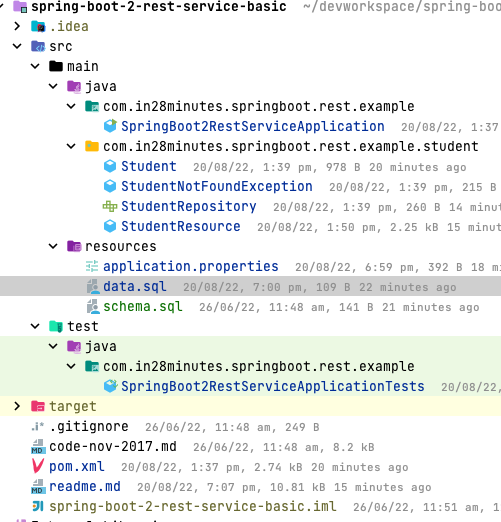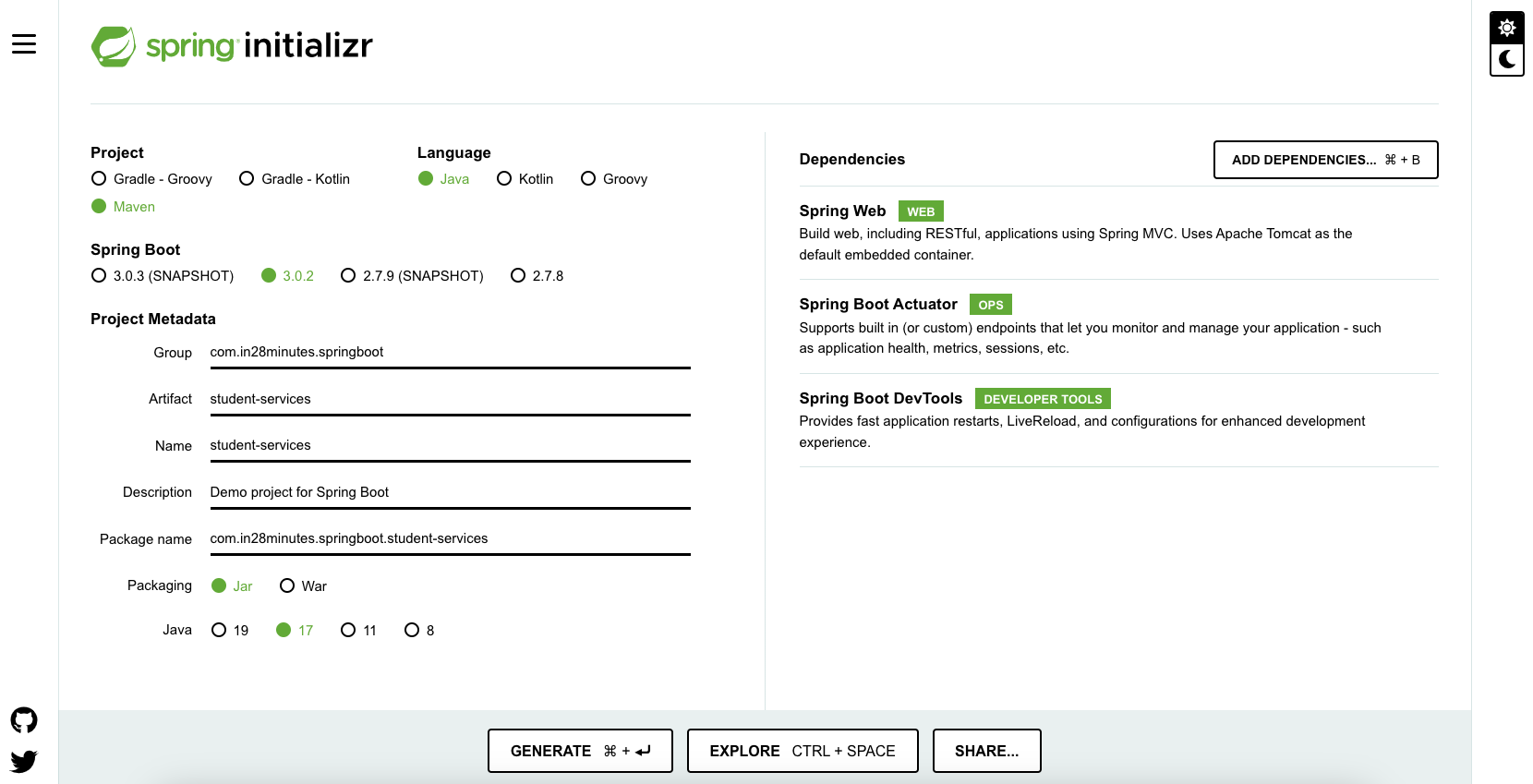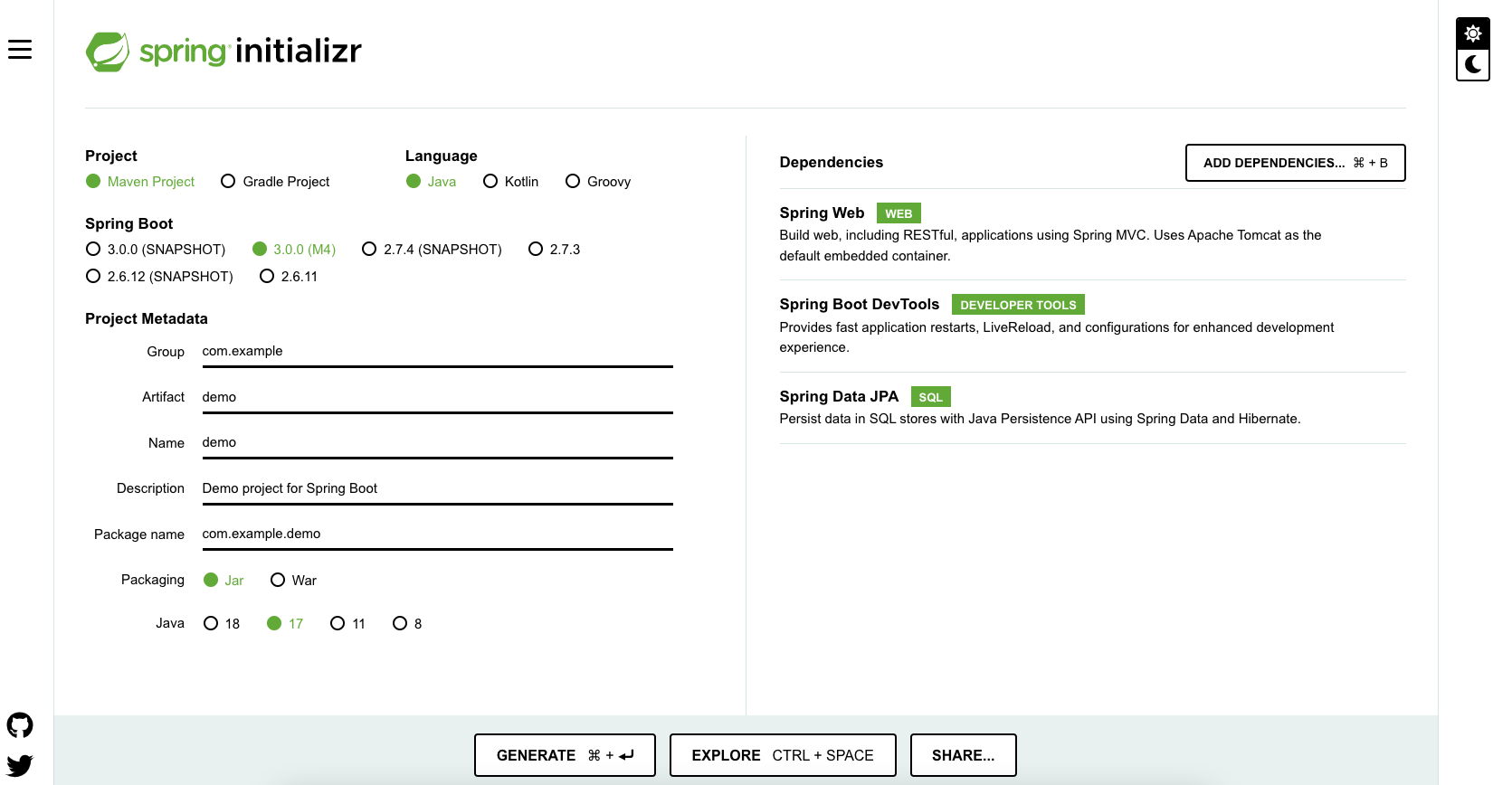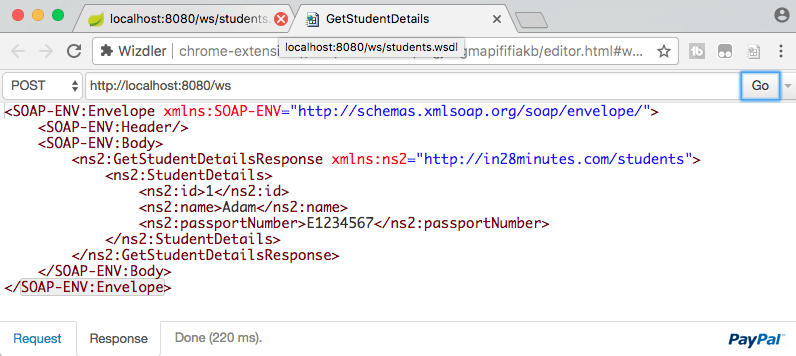Creating a SOAP Web Service With Spring Boot Starter Web Services
In this post, we cover the concepts of SOAP and REST and show you all the code you need to use SOAP web services in a Spring Boot app.
Join the DZone community and get the full member experience.
Join For FreeThis article will help you create a SOAP Web Service with Spring Boot Starter Web Services. We will take a Contract First approach by defining an XSD and exposing a WSDL from it.
We will address the following questions:
- What is a web service?
- What are the different types of web services?
- What is a SOAP Web Service?
- What is SOAP?
- What is a SOAP Envelope?
- What is a SOAP Header and SOAP Body?
- What is a WSDL (Web Service Definition Language)?
- What are the different parts of a WSDL?
- What is the Contract First Approach?
- What is an XSD?
- What is JAXB?
- How do you configure a JAXB plugin?
- What is an endpoint?
- Can you show an example endpoint written with Spring Web Services?
- What is a MessageDispatcherServlet?
- How do you configure a MessageDispatcherServlet?
- How do you generate a WSDL using Spring Web Services?
Resources Overview
In this post, we will create a Student Resource exposing three services using proper URIs and HTTP methods:
- Retrieve all Students - @GetMapping(“/students”)
- Get details about a specific student - @GetMapping(“/students/{id}”)
- Delete a student - @DeleteMapping(“/students/{id}”)
- Create a new student - @PostMapping(“/students”)
- Update student details - @PutMapping(“/students/{id}”)
Project Code Structure
The following screenshot shows the structure of the project we will create. 
A few details:
- SpringBoot2RestServiceApplication.java - The Spring Boot Application class generated with Spring Initializer. This class acts as the launching point for the application.
pom.xml- Contains all the dependencies needed to build this project. We will use Spring Boot Starter AOP.Student.java- Student JPA Entity- StudentRepository.java - Student JPA Repository. This is created using Spring Data JpaRepository.
- StudentResource.java - Spring REST Controller exposing all services on the student's resource.
- data.sql - Initial data for the student table. Spring Boot would execute this script after the tables are created from the entities.
Tools You Will Need
- Maven 3.0+ is your build tool.
- Your favorite IDE. We use Eclipse.
- JDK 1.8+
Complete Maven Project With Code Examples
Our GitHub repository has all the code examples.
What Is a Web Service?
Service delivered over the web
Is this really a complete definition? Is everything that's delivered over the web a Web Service?
The key things to understand are:
- Web services are designed for machine-to-machine (or application-to-application) interaction.
- Web services should be interoperable; not platform dependent.
- Web services should allow for communication over a network.
Types of Web Services
Not really types but a broad classification:
- SOAP
- REST
These are not really mutually exclusive. Some SOAP services can actually be RESTful.
SOAP
SOAP is an abbreviation for Simple Object Access Protocol. In SOAP, the request and response are in XML format. However, not all types of XML are valid SOAP requests.
SOAP defines a standard XML format. We will use WSDL (Web Service Definition Language) to define the format of request XML and the response XML.
Now let's say Facebook wants to know how to call the todo service. What should I give to the Facebook developer?
I will give him a WSDL of the todo service. It will explain:
- What are the different services (operations) exposed by the server?
- How can a service (operation) be called? What URL should we use (also called the endpoint)?
- How should we structure the request XML?
- How should we structure of response XML?
The SOAP format defines a SOAP envelope which envelopes the entire document.
- SOAP Header (optional) - Contains any information needed to identify the request. Also, part of the Header is the authentication and authorization information (signatures, encrypted information, etc).
- SOAP Body - Contains the real XML content for requests or responses.
- In the case of an error response, the server responds back with SOAP Fault.
REST vs SOAP
REST vs SOAP is not a great comparison. REST is an architectural style. SOAP is a message exchange format.
Let’s compare the popular implementations of REST and SOAP styles.
- RESTful sample implementation: JSON over HTTP.
- SOAP sample implementation: XML over SOAP over HTTP.
The following are the important things to consider:
- REST is built over simple HTTP protocol. SOAP services are more complex to implement and more complex to consume.
- REST has better performance and scalability. REST reads can be cached, SOAP-based reads cannot be cached.
- REST permits many different data formats (JSON is the most popular choice) whereas SOAP only permits XML.
- SOAP services have well defined structure and interface (WSDL) and have a set of well defined standards (WS-Security, WS-AtomicTransaction, and WS-ReliableMessaging). Documentation standards with REST are evolving (we will use Swagger in this post).
SOAP Service Examples
Request
<Envelope xmlns="http://schemas.xmlsoap.org/soap/envelope/">
<Body>
<getCourseDetailsRequest xmlns="http://in28minutes.com/courses">
<id>Course1</id>
</getCourseDetailsRequest>
</Body>
</Envelope>Response
<SOAP-ENV:Envelope xmlns:SOAP-ENV="http://schemas.xmlsoap.org/soap/envelope/">
<SOAP-ENV:Header/>
<SOAP-ENV:Body>
<ns2:getCourseDetailsResponse xmlns:ns2="http://in28minutes.com/courses">
<ns2:course>
<ns2:id>Course1</ns2:id>
<ns2:name>Spring</ns2:name>
<ns2:description>10 Steps</ns2:description>
</ns2:course>
</ns2:getCourseDetailsResponse>
</SOAP-ENV:Body>
</SOAP-ENV:Envelope>Fault
<SOAP-ENV:Envelope xmlns:SOAP-ENV="http://schemas.xmlsoap.org/soap/envelope/">
<SOAP-ENV:Header/>
<SOAP-ENV:Body>
<SOAP-ENV:Fault>
<faultcode>SOAP-ENV:Server</faultcode>
<faultstring xml:lang="en">java.lang.NullPointerException</faultstring>
</SOAP-ENV:Fault>
</SOAP-ENV:Body>
</SOAP-ENV:Envelope>WSDL
WSDL is used to define the structure of requests and responses.
- view-source:http://localhost:8080/ws/courses.wsdl
<?xml version="1.0" encoding="UTF-8" standalone="no"?><wsdl:definitions xmlns:wsdl="http://schemas.xmlsoap.org/wsdl/" xmlns:sch="http://in28minutes.com/courses" xmlns:soap="http://schemas.xmlsoap.org/wsdl/soap/" xmlns:tns="http://in28minutes.com/courses" targetNamespace="http://in28minutes.com/courses">
<wsdl:types>
<xs:schema xmlns:xs="http://www.w3.org/2001/XMLSchema" elementFormDefault="qualified" targetNamespace="http://in28minutes.com/courses">
<xs:element name="getCourseDetailsRequest">
<xs:complexType>
<xs:sequence>
<xs:element name="id" type="xs:string"/>
</xs:sequence>
</xs:complexType>
</xs:element>
<xs:element name="getCourseDetailsResponse">
<xs:complexType>
<xs:sequence>
<xs:element name="course" type="tns:course"/>
</xs:sequence>
</xs:complexType>
</xs:element>
<xs:complexType name="course">
<xs:sequence>
<xs:element name="id" type="xs:string"/>
<xs:element name="name" type="xs:string"/>
<xs:element name="description" type="xs:string"/>
</xs:sequence>
</xs:complexType>
</xs:schema>
</wsdl:types>
<wsdl:message name="getCourseDetailsRequest">
<wsdl:part element="tns:getCourseDetailsRequest" name="getCourseDetailsRequest">
</wsdl:part>
</wsdl:message>
<wsdl:message name="getCourseDetailsResponse">
<wsdl:part element="tns:getCourseDetailsResponse" name="getCourseDetailsResponse">
</wsdl:part>
</wsdl:message>
<wsdl:portType name="CoursesPort">
<wsdl:operation name="getCourseDetails">
<wsdl:input message="tns:getCourseDetailsRequest" name="getCourseDetailsRequest">
</wsdl:input>
<wsdl:output message="tns:getCourseDetailsResponse" name="getCourseDetailsResponse">
</wsdl:output>
</wsdl:operation>
</wsdl:portType>
<wsdl:binding name="CoursesPortSoap11" type="tns:CoursesPort">
<soap:binding style="document" transport="http://schemas.xmlsoap.org/soap/http"/>
<wsdl:operation name="getCourseDetails">
<soap:operation soapAction=""/>
<wsdl:input name="getCourseDetailsRequest">
<soap:body use="literal"/>
</wsdl:input>
<wsdl:output name="getCourseDetailsResponse">
<soap:body use="literal"/>
</wsdl:output>
</wsdl:operation>
</wsdl:binding>
<wsdl:service name="CoursesPortService">
<wsdl:port binding="tns:CoursesPortSoap11" name="CoursesPortSoap11">
<soap:address location="http://localhost:8080/ws"/>
</wsdl:port>
</wsdl:service>
</wsdl:definitions>Bootstrapping With Spring Initializr
Creating a SOAP Web service with Spring Initializr is a cake walk.
Spring Initializr is a great tool to bootstrap your Spring Boot projects.
You can create a wide variety of projects using Spring Initializr.


The following steps have to be done for a Web Services project:
- Launch Spring Initializr and choose the following:
- Choose
com.in28minutes.springboot.soap.web.services.exampleas the Group. - Choose
spring-boot-tutorial-soap-web-servicesas the Artifact. - Choose the following dependencies:
- Web Services
- DevTools
- Choose
- Click 'Generate Project.'
- Import the project into Eclipse. File -> Import -> Existing Maven Project.
Do not forget to add Web Services as a dependency.
Creating a SOAP Web Service With Spring Boot
We will use a contract first approach and first define the XSD for the request and response.
Define XSD for Request and Response
/src/main/resources/student-details.xsd
<?xml version="1.0" encoding="UTF-8"?>
<xs:schema xmlns:xs="http://www.w3.org/2001/XMLSchema"
targetNamespace="http://in28minutes.com/students"
xmlns:tns="http://in28minutes.com/students" elementFormDefault="qualified">
<xs:element name="GetStudentDetailsRequest">
<xs:complexType>
<xs:sequence>
<xs:element name= "id" type="xs:int"/>
</xs:sequence>
</xs:complexType>
</xs:element>
<xs:element name="GetStudentDetailsResponse">
<xs:complexType>
<xs:sequence>
<xs:element name= "StudentDetails" type="tns:StudentDetails"/>
</xs:sequence>
</xs:complexType>
</xs:element>
<xs:complexType name="StudentDetails">
<xs:sequence>
<xs:element name="id" type="xs:int"/>
<xs:element name="name" type="xs:string"/>
<xs:element name="passportNumber" type="xs:string"/>
</xs:sequence>
</xs:complexType>
</xs:schema>We are create a simple xsd defining the request GetStudentDetailsRequest and the response GetStudentDetailsResponse.
Example requests and responses are shown below.
Request
<Envelope xmlns="http://schemas.xmlsoap.org/soap/envelope/">
<Body>
<GetStudentDetailsRequest xmlns="http://in28minutes.com/students">
<id>1</id>
</GetStudentDetailsRequest>
</Body>
</Envelope>Response
<SOAP-ENV:Envelope xmlns:SOAP-ENV="http://schemas.xmlsoap.org/soap/envelope/">
<SOAP-ENV:Header/>
<SOAP-ENV:Body>
<ns2:GetStudentDetailsResponse xmlns:ns2="http://in28minutes.com/students">
<ns2:StudentDetails>
<ns2:id>1</ns2:id>
<ns2:name>Adam</ns2:name>
<ns2:passportNumber>E1234567</ns2:passportNumber>
</ns2:StudentDetails>
</ns2:GetStudentDetailsResponse>
</SOAP-ENV:Body>
</SOAP-ENV:Envelope>Java API for XML Binding (JAXB) and Configuring a JAXB 2 Maven Plugin
When we implement our code using Spring Web Services, the following steps are typically involved in processing a request:
- Map Request XML to Java Request Objects.
- Perform the business logic and create the Java Response Objects.
- Map the Response Object to a Response XML and return the response.
We do the mapping from XML to Java and Java to XML. This is done using JAXB — a Java API for XML binding.
A Maven JAXB Plugin helps us in generating the Java objects based on the XSD. Let's add it to our pom.xml.
<plugin>
<groupId>org.codehaus.mojo</groupId>
<artifactId>jaxb2-maven-plugin</artifactId>
<version>1.6</version>
<executions>
<execution>
<id>xjc</id>
<goals>
<goal>xjc</goal>
</goals>
</execution>
</executions>
<configuration>
<schemaDirectory>${project.basedir}/src/main/resources</schemaDirectory>
<outputDirectory>${project.basedir}/src/main/java</outputDirectory>
<clearOutputDir>false</clearOutputDir>
</configuration>
</plugin>Three important configurations:
<schemaDirectory>${project.basedir}/src/main/resources</schemaDirectory>- The location of XSD files.<outputDirectory>${project.basedir}/src/main/java</outputDirectory>- Where do you want your Java code to be generated?<clearOutputDir>false</clearOutputDir>- Should the output directory be cleaned every time? We use false because we write our Java source code in the same directory.
Configuring an Endpoint for GetCourseDetailsRequest
The endpoint is the component that receives the request, initiates the processing, and sends the response back.
Let’s first create a bean for storing the student details.
/src/main/java/com/in28minutes/springboot/soap/web/services/example/student/Student.java
package com.in28minutes.springboot.soap.web.services.example.student;
public class Student {
private Long id;
private String name;
private String passportNumber;
public Student() {
super();
}
public Student(Long id, String name, String passportNumber) {
super();
this.id = id;
this.name = name;
this.passportNumber = passportNumber;
}
public Student(String name, String passportNumber) {
super();
this.name = name;
this.passportNumber = passportNumber;
}
// Getters and Setters omitted
@Override
public String toString() {
return String.format("Student [id=%s, name=%s, passportNumber=%s]", id, name, passportNumber);
}
}/src/main/java/com/in28minutes/springboot/soap/web/services/example/student/StudentDetailsEndpoint.java
package com.in28minutes.springboot.soap.web.services.example.student;
import org.springframework.ws.server.endpoint.annotation.Endpoint;
import org.springframework.ws.server.endpoint.annotation.PayloadRoot;
import org.springframework.ws.server.endpoint.annotation.RequestPayload;
import org.springframework.ws.server.endpoint.annotation.ResponsePayload;
import com.in28minutes.students.GetStudentDetailsRequest;
import com.in28minutes.students.GetStudentDetailsResponse;
import com.in28minutes.students.StudentDetails;
@Endpoint
public class StudentDetailsEndpoint {
@PayloadRoot(namespace = "http://in28minutes.com/students", localPart = "GetStudentDetailsRequest")
@ResponsePayload
public GetStudentDetailsResponse processCourseDetailsRequest(@RequestPayload GetStudentDetailsRequest request) {
GetStudentDetailsResponse response = new GetStudentDetailsResponse();
StudentDetails studentDetails = new StudentDetails();
studentDetails.setId(request.getId());
studentDetails.setName("Adam");
studentDetails.setPassportNumber("E1234567");
response.setStudentDetails(studentDetails);
return response;
}
}A few important things to note:
@Endpoint- Annotation to indicate that this is a Web Service Endpoint.@PayloadRoot(namespace = "http://in28minutes.com/students", localPart = "GetStudentDetailsRequest")- Defines the details of the request that this method will handle. We will handleGetStudentDetailsRequestwith the given namespace.@ResponsePayload- This method will return a response which will need to be converted to a response XML.public GetStudentDetailsResponse processCourseDetailsRequest(@RequestPayload GetStudentDetailsRequest request)- Thi method will handle the request.@RequestPayloadindicates that this is obtained from the request.
Configure the Message Dispatcher Servlet to Receive the Request
/src/main/java/com/in28minutes/springboot/soap/web/services/example/WebServiceConfig.java
@EnableWs
@Configuration
public class WebServiceConfig {
@Bean
public ServletRegistrationBean messageDispatcherServlet(ApplicationContext context) {
MessageDispatcherServlet messageDispatcherServlet = new MessageDispatcherServlet();
messageDispatcherServlet.setApplicationContext(context);
messageDispatcherServlet.setTransformWsdlLocations(true);
return new ServletRegistrationBean(messageDispatcherServlet, "/ws/*");
}
}Notes:
@EnableWs- Enable SOAP Web Service features in this Spring Boot application.@Configuration- This class contains the Spring configuration.@Bean public ServletRegistrationBean messageDispatcherServlet(ApplicationContext context)- We will want to create a message dispatcher servlet to act as a front controller.return new ServletRegistrationBean(messageDispatcherServlet, "/ws/*")- Configure the URL to the web services.
Spring Web Services Configuration to Generate WSDL
Let's add the wsdl4j dependency to our pom.xml.
/pom.xml
<dependency>
<groupId>wsdl4j</groupId>
<artifactId>wsdl4j</artifactId>
</dependency>Let’s enhance the WebServiceConfig to expose the WSDL.
/src/main/java/com/in28minutes/springboot/soap/web/services/example/WebServiceConfig.java
@Bean(name = "students")
public DefaultWsdl11Definition defaultWsdl11Definition(XsdSchema studentsSchema) {
DefaultWsdl11Definition definition = new DefaultWsdl11Definition();
definition.setPortTypeName("StudentPort");
definition.setTargetNamespace("http://in28minutes.com/students");
definition.setLocationUri("/ws");
definition.setSchema(studentsSchema);
return definition;
}
@Bean
public XsdSchema studentsSchema() {
return new SimpleXsdSchema(new ClassPathResource("student-details.xsd"));
}Notes
@Bean(name = "students")- A Spring bean. The name of the bean is the name of the WSDL in the URL.DefaultWsdl11Definition defaultWsdl11Definition(XsdSchema studentsSchema)definition.setTargetNamespace("http://in28minutes.com/students")- Default namespacedefinition.setLocationUri("/ws")- The URL where we want to expose the WSDL.definition.setSchema(studentsSchema)- We will create the WSDL based on the xsd defined here:new SimpleXsdSchema(new ClassPathResource("student-details.xsd"))
URL of the WSDL - http://localhost:8080/ws/students.wsdl
<?xml version="1.0" encoding="UTF-8" standalone="no"?><wsdl:definitions xmlns:wsdl="http://schemas.xmlsoap.org/wsdl/" xmlns:sch="http://in28minutes.com/students" xmlns:soap="http://schemas.xmlsoap.org/wsdl/soap/" xmlns:tns="http://in28minutes.com/students" targetNamespace="http://in28minutes.com/students">
<wsdl:types>
<xs:schema xmlns:xs="http://www.w3.org/2001/XMLSchema" elementFormDefault="qualified" targetNamespace="http://in28minutes.com/students">
<xs:element name="GetStudentDetailsRequest">
<xs:complexType>
<xs:sequence>
<xs:element name="id" type="xs:int"/>
</xs:sequence>
</xs:complexType>
</xs:element>
<xs:element name="GetStudentDetailsResponse">
<xs:complexType>
<xs:sequence>
<xs:element name="StudentDetails" type="tns:StudentDetails"/>
</xs:sequence>
</xs:complexType>
</xs:element>
<xs:complexType name="StudentDetails">
<xs:sequence>
<xs:element name="id" type="xs:int"/>
<xs:element name="name" type="xs:string"/>
<xs:element name="passportNumber" type="xs:string"/>
</xs:sequence>
</xs:complexType>
</xs:schema>
</wsdl:types>
<wsdl:message name="GetStudentDetailsResponse">
<wsdl:part element="tns:GetStudentDetailsResponse" name="GetStudentDetailsResponse">
</wsdl:part>
</wsdl:message>
<wsdl:message name="GetStudentDetailsRequest">
<wsdl:part element="tns:GetStudentDetailsRequest" name="GetStudentDetailsRequest">
</wsdl:part>
</wsdl:message>
<wsdl:portType name="StudentPort">
<wsdl:operation name="GetStudentDetails">
<wsdl:input message="tns:GetStudentDetailsRequest" name="GetStudentDetailsRequest">
</wsdl:input>
<wsdl:output message="tns:GetStudentDetailsResponse" name="GetStudentDetailsResponse">
</wsdl:output>
</wsdl:operation>
</wsdl:portType>
<wsdl:binding name="StudentPortSoap11" type="tns:StudentPort">
<soap:binding transport="http://schemas.xmlsoap.org/soap/http"/>
<wsdl:operation name="GetStudentDetails">
<soap:operation soapAction=""/>
<wsdl:input name="GetStudentDetailsRequest">
<soap:body use="literal"/>
</wsdl:input>
<wsdl:output name="GetStudentDetailsResponse">
<soap:body use="literal"/>
</wsdl:output>
</wsdl:operation>
</wsdl:binding>
<wsdl:service name="StudentPortService">
<wsdl:port binding="tns:StudentPortSoap11" name="StudentPortSoap11">
<soap:address location="http://localhost:8080/ws"/>
</wsdl:port>
</wsdl:service>
</wsdl:definitions>Executing a Request Using Wizdler
Install the Chrome plugin Wizdler.
Once you install Wizdler and launch the WSDL URL, http://localhost:8080/ws/students.wsdl, you will see a small icon at the corner of the Chrome browser, which you can click to see the services that are part of the WSDL. Go ahead and click the Wizdler icon and click the service GetStudentDetails
This will launch a window to execute the request. Change the ID to 1. Click the 'Go' button at the top right corner of the screen. 
You should see the response as shown below. 
Request
<Envelope xmlns="http://schemas.xmlsoap.org/soap/envelope/">
<Body>
<GetStudentDetailsRequest xmlns="http://in28minutes.com/students">
<id>1</id>
</GetStudentDetailsRequest>
</Body>
</Envelope>Response
<SOAP-ENV:Envelope xmlns:SOAP-ENV="http://schemas.xmlsoap.org/soap/envelope/">
<SOAP-ENV:Header/>
<SOAP-ENV:Body>
<ns2:GetStudentDetailsResponse xmlns:ns2="http://in28minutes.com/students">
<ns2:StudentDetails>
<ns2:id>1</ns2:id>
<ns2:name>Adam</ns2:name>
<ns2:passportNumber>E1234567</ns2:passportNumber>
</ns2:StudentDetails>
</ns2:GetStudentDetailsResponse>
</SOAP-ENV:Body>
</SOAP-ENV:Envelope>More SOAP Methods
You can enhance the endpoint to expose more operations. The steps would be:
- Define the structure for request and response in XSD.
- Enhance the endpoint to process the request.
- Go ahead and test it.
Another thing you can work on is to remove the hardcoding and add business logic and persistence stuff using JPA.
Good Luck!
Next Steps
- Learn Basics of Spring Boot - Spring Boot vs Spring vs Spring MVC, Auto Configuration, Spring Boot Starter Projects, Spring Boot Starter Parent, Spring Boot Initializr
- Learn RESTful and SOAP Web Services with Spring Boot
- Learn Microservices with Spring Boot and Spring Cloud
Complete Code Example
/pom.xml
<?xml version="1.0" encoding="UTF-8"?>
<project xmlns="http://maven.apache.org/POM/4.0.0" xmlns:xsi="http://www.w3.org/2001/XMLSchema-instance"
xsi:schemaLocation="http://maven.apache.org/POM/4.0.0 http://maven.apache.org/xsd/maven-4.0.0.xsd">
<modelVersion>4.0.0</modelVersion>
<groupId>com.in28minutes.springboot.soap.web.services.example</groupId>
<artifactId>spring-boot-tutorial-soap-web-services</artifactId>
<version>0.0.1-SNAPSHOT</version>
<packaging>jar</packaging>
<name>spring-boot-tutorial-soap-web-services</name>
<description>SOAP Web Services with Spring Boot</description>
<parent>
<groupId>org.springframework.boot</groupId>
<artifactId>spring-boot-starter-parent</artifactId>
<version>2.0.0.RELEASE</version>
<relativePath /> <!-- lookup parent from repository -->
</parent>
<properties>
<project.build.sourceEncoding>UTF-8</project.build.sourceEncoding>
<project.reporting.outputEncoding>UTF-8</project.reporting.outputEncoding>
<java.version>1.8</java.version>
</properties>
<dependencies>
<dependency>
<groupId>org.springframework.boot</groupId>
<artifactId>spring-boot-starter-web-services</artifactId>
</dependency>
<dependency>
<groupId>wsdl4j</groupId>
<artifactId>wsdl4j</artifactId>
</dependency>
<dependency>
<groupId>org.springframework.boot</groupId>
<artifactId>spring-boot-devtools</artifactId>
<scope>runtime</scope>
</dependency>
<dependency>
<groupId>org.springframework.boot</groupId>
<artifactId>spring-boot-starter-test</artifactId>
<scope>test</scope>
</dependency>
</dependencies>
<build>
<plugins>
<plugin>
<groupId>org.springframework.boot</groupId>
<artifactId>spring-boot-maven-plugin</artifactId>
</plugin>
<plugin>
<groupId>org.codehaus.mojo</groupId>
<artifactId>jaxb2-maven-plugin</artifactId>
<version>1.6</version>
<executions>
<execution>
<id>xjc</id>
<goals>
<goal>xjc</goal>
</goals>
</execution>
</executions>
<configuration>
<schemaDirectory>${project.basedir}/src/main/resources</schemaDirectory>
<outputDirectory>${project.basedir}/src/main/java</outputDirectory>
<clearOutputDir>false</clearOutputDir>
</configuration>
</plugin>
</plugins>
</build>
<repositories>
<repository>
<id>spring-snapshots</id>
<name>Spring Snapshots</name>
<url>https://repo.spring.io/snapshot</url>
<snapshots>
<enabled>true</enabled>
</snapshots>
</repository>
<repository>
<id>spring-milestones</id>
<name>Spring Milestones</name>
<url>https://repo.spring.io/milestone</url>
<snapshots>
<enabled>false</enabled>
</snapshots>
</repository>
</repositories>
<pluginRepositories>
<pluginRepository>
<id>spring-snapshots</id>
<name>Spring Snapshots</name>
<url>https://repo.spring.io/snapshot</url>
<snapshots>
<enabled>true</enabled>
</snapshots>
</pluginRepository>
<pluginRepository>
<id>spring-milestones</id>
<name>Spring Milestones</name>
<url>https://repo.spring.io/milestone</url>
<snapshots>
<enabled>false</enabled>
</snapshots>
</pluginRepository>
</pluginRepositories>
</project>
<!-- http://localhost:8080/ws/students.wsdl -->/src/main/java/com/in28minutes/springboot/soap/web/services/example/SpringBootTutorialSoapWebServicesApplication.java
package com.in28minutes.springboot.soap.web.services.example;
import org.springframework.boot.SpringApplication;
import org.springframework.boot.autoconfigure.SpringBootApplication;
@SpringBootApplication
public class SpringBootTutorialSoapWebServicesApplication {
public static void main(String[] args) {
SpringApplication.run(SpringBootTutorialSoapWebServicesApplication.class, args);
}
}/src/main/java/com/in28minutes/springboot/soap/web/services/example/student/Student.java
package com.in28minutes.springboot.soap.web.services.example.student;
public class Student {
private Long id;
private String name;
private String passportNumber;
public Student() {
super();
}
public Student(Long id, String name, String passportNumber) {
super();
this.id = id;
this.name = name;
this.passportNumber = passportNumber;
}
public Student(String name, String passportNumber) {
super();
this.name = name;
this.passportNumber = passportNumber;
}
public Long getId() {
return id;
}
public void setId(Long id) {
this.id = id;
}
public String getName() {
return name;
}
public void setName(String name) {
this.name = name;
}
public String getPassportNumber() {
return passportNumber;
}
public void setPassportNumber(String passportNumber) {
this.passportNumber = passportNumber;
}
@Override
public String toString() {
return String.format("Student [id=%s, name=%s, passportNumber=%s]", id, name, passportNumber);
}
}/src/main/java/com/in28minutes/springboot/soap/web/services/example/student/StudentDetailsEndpoint.java
package com.in28minutes.springboot.soap.web.services.example.student;
import org.springframework.ws.server.endpoint.annotation.Endpoint;
import org.springframework.ws.server.endpoint.annotation.PayloadRoot;
import org.springframework.ws.server.endpoint.annotation.RequestPayload;
import org.springframework.ws.server.endpoint.annotation.ResponsePayload;
import com.in28minutes.students.GetStudentDetailsRequest;
import com.in28minutes.students.GetStudentDetailsResponse;
import com.in28minutes.students.StudentDetails;
@Endpoint
public class StudentDetailsEndpoint {
@PayloadRoot(namespace = "http://in28minutes.com/students", localPart = "GetStudentDetailsRequest")
@ResponsePayload
public GetStudentDetailsResponse processCourseDetailsRequest(@RequestPayload GetStudentDetailsRequest request) {
GetStudentDetailsResponse response = new GetStudentDetailsResponse();
StudentDetails studentDetails = new StudentDetails();
studentDetails.setId(request.getId());
studentDetails.setName("Adam");
studentDetails.setPassportNumber("E1234567");
response.setStudentDetails(studentDetails);
return response;
}
}/src/main/java/com/in28minutes/springboot/soap/web/services/example/WebServiceConfig.java
package com.in28minutes.springboot.soap.web.services.example;
import org.springframework.boot.web.servlet.ServletRegistrationBean;
import org.springframework.context.ApplicationContext;
import org.springframework.context.annotation.Bean;
import org.springframework.context.annotation.Configuration;
import org.springframework.core.io.ClassPathResource;
import org.springframework.ws.config.annotation.EnableWs;
import org.springframework.ws.transport.http.MessageDispatcherServlet;
import org.springframework.ws.wsdl.wsdl11.DefaultWsdl11Definition;
import org.springframework.xml.xsd.SimpleXsdSchema;
import org.springframework.xml.xsd.XsdSchema;
@EnableWs
@Configuration
public class WebServiceConfig {
@Bean
public ServletRegistrationBean messageDispatcherServlet(ApplicationContext context) {
MessageDispatcherServlet messageDispatcherServlet = new MessageDispatcherServlet();
messageDispatcherServlet.setApplicationContext(context);
messageDispatcherServlet.setTransformWsdlLocations(true);
return new ServletRegistrationBean(messageDispatcherServlet, "/ws/*");
}
@Bean(name = "students")
public DefaultWsdl11Definition defaultWsdl11Definition(XsdSchema studentsSchema) {
DefaultWsdl11Definition definition = new DefaultWsdl11Definition();
definition.setPortTypeName("StudentPort");
definition.setTargetNamespace("http://in28minutes.com/students");
definition.setLocationUri("/ws");
definition.setSchema(studentsSchema);
return definition;
}
@Bean
public XsdSchema studentsSchema() {
return new SimpleXsdSchema(new ClassPathResource("student-details.xsd"));
}
}/src/main/java/com/in28minutes/students/GetStudentDetailsRequest.java
//
// This file was generated by the JavaTM Architecture for XML Binding(JAXB) Reference Implementation, v2.2.7
// See <a href="http://java.sun.com/xml/jaxb">http://java.sun.com/xml/jaxb</a>
// Any modifications to this file will be lost upon recompilation of the source schema.
// Generated on: 2017.11.28 at 02:57:40 PM IST
//
package com.in28minutes.students;
import javax.xml.bind.annotation.XmlAccessType;
import javax.xml.bind.annotation.XmlAccessorType;
import javax.xml.bind.annotation.XmlRootElement;
import javax.xml.bind.annotation.XmlType;
/**
* <p>Java class for anonymous complex type.
*
* <p>The following schema fragment specifies the expected content contained within this class.
*
* <pre>
* <complexType>
* <complexContent>
* <restriction base="{http://www.w3.org/2001/XMLSchema}anyType">
* <sequence>
* <element name="id" type="{http://www.w3.org/2001/XMLSchema}int"/>
* </sequence>
* </restriction>
* </complexContent>
* </complexType>
* </pre>
*
*
*/
@XmlAccessorType(XmlAccessType.FIELD)
@XmlType(name = "", propOrder = {
"id"
})
@XmlRootElement(name = "GetStudentDetailsRequest")
public class GetStudentDetailsRequest {
protected int id;
/**
* Gets the value of the id property.
*
*/
public int getId() {
return id;
}
/**
* Sets the value of the id property.
*
*/
public void setId(int value) {
this.id = value;
}
}/src/main/java/com/in28minutes/students/GetStudentDetailsResponse.java
//
// This file was generated by the JavaTM Architecture for XML Binding(JAXB) Reference Implementation, v2.2.7
// See <a href="http://java.sun.com/xml/jaxb">http://java.sun.com/xml/jaxb</a>
// Any modifications to this file will be lost upon recompilation of the source schema.
// Generated on: 2017.11.28 at 02:57:40 PM IST
//
package com.in28minutes.students;
import javax.xml.bind.annotation.XmlAccessType;
import javax.xml.bind.annotation.XmlAccessorType;
import javax.xml.bind.annotation.XmlElement;
import javax.xml.bind.annotation.XmlRootElement;
import javax.xml.bind.annotation.XmlType;
/**
* <p>Java class for anonymous complex type.
*
* <p>The following schema fragment specifies the expected content contained within this class.
*
* <pre>
* <complexType>
* <complexContent>
* <restriction base="{http://www.w3.org/2001/XMLSchema}anyType">
* <sequence>
* <element name="StudentDetails" type="{http://in28minutes.com/students}StudentDetails"/>
* </sequence>
* </restriction>
* </complexContent>
* </complexType>
* </pre>
*
*
*/
@XmlAccessorType(XmlAccessType.FIELD)
@XmlType(name = "", propOrder = {
"studentDetails"
})
@XmlRootElement(name = "GetStudentDetailsResponse")
public class GetStudentDetailsResponse {
@XmlElement(name = "StudentDetails", required = true)
protected StudentDetails studentDetails;
/**
* Gets the value of the studentDetails property.
*
* @return
* possible object is
* {@link StudentDetails }
*
*/
public StudentDetails getStudentDetails() {
return studentDetails;
}
/**
* Sets the value of the studentDetails property.
*
* @param value
* allowed object is
* {@link StudentDetails }
*
*/
public void setStudentDetails(StudentDetails value) {
this.studentDetails = value;
}
}/src/main/java/com/in28minutes/students/ObjectFactory.java
//
// This file was generated by the JavaTM Architecture for XML Binding(JAXB) Reference Implementation, v2.2.7
// See <a href="http://java.sun.com/xml/jaxb">http://java.sun.com/xml/jaxb</a>
// Any modifications to this file will be lost upon recompilation of the source schema.
// Generated on: 2017.11.28 at 02:57:40 PM IST
//
package com.in28minutes.students;
import javax.xml.bind.annotation.XmlRegistry;
/**
* This object contains factory methods for each
* Java content interface and Java element interface
* generated in the com.in28minutes.students package.
* <p>An ObjectFactory allows you to programatically
* construct new instances of the Java representation
* for XML content. The Java representation of XML
* content can consist of schema derived interfaces
* and classes representing the binding of schema
* type definitions, element declarations and model
* groups. Factory methods for each of these are
* provided in this class.
*
*/
@XmlRegistry
public class ObjectFactory {
/**
* Create a new ObjectFactory that can be used to create new instances of schema derived classes for package: com.in28minutes.students
*
*/
public ObjectFactory() {
}
/**
* Create an instance of {@link GetStudentDetailsResponse }
*
*/
public GetStudentDetailsResponse createGetStudentDetailsResponse() {
return new GetStudentDetailsResponse();
}
/**
* Create an instance of {@link StudentDetails }
*
*/
public StudentDetails createStudentDetails() {
return new StudentDetails();
}
/**
* Create an instance of {@link GetStudentDetailsRequest }
*
*/
public GetStudentDetailsRequest createGetStudentDetailsRequest() {
return new GetStudentDetailsRequest();
}
}/src/main/java/com/in28minutes/students/package-info.java
//
// This file was generated by the JavaTM Architecture for XML Binding(JAXB) Reference Implementation, v2.2.7
// See <a href="http://java.sun.com/xml/jaxb">http://java.sun.com/xml/jaxb</a>
// Any modifications to this file will be lost upon recompilation of the source schema.
// Generated on: 2017.11.28 at 02:57:40 PM IST
//
@javax.xml.bind.annotation.XmlSchema(namespace = "http://in28minutes.com/students", elementFormDefault = javax.xml.bind.annotation.XmlNsForm.QUALIFIED)
package com.in28minutes.students;/src/main/java/com/in28minutes/students/StudentDetails.java
//
// This file was generated by the JavaTM Architecture for XML Binding(JAXB) Reference Implementation, v2.2.7
// See <a href="http://java.sun.com/xml/jaxb">http://java.sun.com/xml/jaxb</a>
// Any modifications to this file will be lost upon recompilation of the source schema.
// Generated on: 2017.11.28 at 02:57:40 PM IST
//
package com.in28minutes.students;
import javax.xml.bind.annotation.XmlAccessType;
import javax.xml.bind.annotation.XmlAccessorType;
import javax.xml.bind.annotation.XmlElement;
import javax.xml.bind.annotation.XmlType;
/**
* <p>Java class for StudentDetails complex type.
*
* <p>The following schema fragment specifies the expected content contained within this class.
*
* <pre>
* <complexType name="StudentDetails">
* <complexContent>
* <restriction base="{http://www.w3.org/2001/XMLSchema}anyType">
* <sequence>
* <element name="id" type="{http://www.w3.org/2001/XMLSchema}int"/>
* <element name="name" type="{http://www.w3.org/2001/XMLSchema}string"/>
* <element name="passportNumber" type="{http://www.w3.org/2001/XMLSchema}string"/>
* </sequence>
* </restriction>
* </complexContent>
* </complexType>
* </pre>
*
*
*/
@XmlAccessorType(XmlAccessType.FIELD)
@XmlType(name = "StudentDetails", propOrder = {
"id",
"name",
"passportNumber"
})
public class StudentDetails {
protected int id;
@XmlElement(required = true)
protected String name;
@XmlElement(required = true)
protected String passportNumber;
/**
* Gets the value of the id property.
*
*/
public int getId() {
return id;
}
/**
* Sets the value of the id property.
*
*/
public void setId(int value) {
this.id = value;
}
/**
* Gets the value of the name property.
*
* @return
* possible object is
* {@link String }
*
*/
public String getName() {
return name;
}
/**
* Sets the value of the name property.
*
* @param value
* allowed object is
* {@link String }
*
*/
public void setName(String value) {
this.name = value;
}
/**
* Gets the value of the passportNumber property.
*
* @return
* possible object is
* {@link String }
*
*/
public String getPassportNumber() {
return passportNumber;
}
/**
* Sets the value of the passportNumber property.
*
* @param value
* allowed object is
* {@link String }
*
*/
public void setPassportNumber(String value) {
this.passportNumber = value;
}
}/src/main/resources/student-details.xsd
<?xml version="1.0" encoding="UTF-8"?>
<xs:schema xmlns:xs="http://www.w3.org/2001/XMLSchema"
targetNamespace="http://in28minutes.com/students"
xmlns:tns="http://in28minutes.com/students" elementFormDefault="qualified">
<xs:element name="GetStudentDetailsRequest">
<xs:complexType>
<xs:sequence>
<xs:element name= "id" type="xs:int"/>
</xs:sequence>
</xs:complexType>
</xs:element>
<xs:element name="GetStudentDetailsResponse">
<xs:complexType>
<xs:sequence>
<xs:element name= "StudentDetails" type="tns:StudentDetails"/>
</xs:sequence>
</xs:complexType>
</xs:element>
<xs:complexType name="StudentDetails">
<xs:sequence>
<xs:element name="id" type="xs:int"/>
<xs:element name="name" type="xs:string"/>
<xs:element name="passportNumber" type="xs:string"/>
</xs:sequence>
</xs:complexType>
</xs:schema>/src/test/java/com/in28minutes/springboot/soap/web/services/example/SpringBootTutorialSoapWebServicesApplicationTests.java
package com.in28minutes.springboot.soap.web.services.example;
import org.junit.Test;
import org.junit.runner.RunWith;
import org.springframework.boot.test.context.SpringBootTest;
import org.springframework.test.context.junit4.SpringRunner;
@RunWith(SpringRunner.class)
@SpringBootTest
public class SpringBootTutorialSoapWebServicesApplicationTests {
@Test
public void contextLoads() {
}
}Opinions expressed by DZone contributors are their own.

Comments